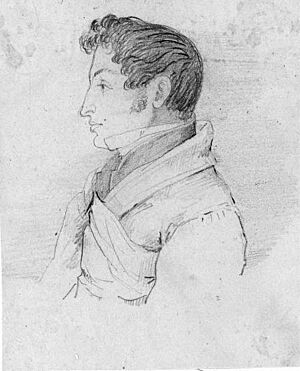Johan Jakob Nervander facts for kids
Quick facts for kids
Johan Jakob Nervander
|
|
|---|---|
 |
|
| Born | 23 February 1805 Uusikaupunki
|
| Died | 15 March 1848 (aged 43) |
| Nationality | Finnish |
| Awards | Demidov Prize |
| Scientific career | |
| Fields | Physics |
Johan Jakob Nervander (born February 23, 1805 – died March 15, 1848) was a smart Finnish scientist. He was a poet, a physicist (someone who studies how things work in nature), and a meteorologist (someone who studies weather).
Contents
Early Life and Studies
Johan Jakob Nervander was born in Uusikaupunki, Finland. His father, Johan Nervander, was a pharmacist.
In 1820, when he was about 15 years old, Nervander became a student. He went to the Royal Academy of Turku. There, he became good friends with another famous Finnish person, Johan Ludvig Runeberg.
Exciting European Journey
From 1832 to 1836, Nervander went on a long trip. He traveled all over central and southern Europe. He got a special scholarship (money to help him study) from the Royal Academy of Turku for this journey.
During his travels, he met some very important scientists. In Göttingen, he met Wilhelm Eduard Weber and Carl Friedrich Gauss. These meetings made him very interested in geomagnetism. Geomagnetism is the study of Earth's magnetic field.
Building an Observatory
After his trip, Nervander returned to Finland. He traveled through Stockholm and Saint Petersburg. In Saint Petersburg, he met a scientist named Adolph Theodor Kupffer. Kupffer was the director of the Saint Petersburg Academy of Sciences.
Nervander shared his idea to build a special place in Helsinki. This place would be a magnetic observatory. An observatory is a building where scientists watch and measure things. Kupffer liked the idea and supported him.
The new buildings for the observatory were built in Kaisaniemi Park in Helsinki. Nervander became the very first director of this new observatory.
Important Discoveries
The Helsinki observatory started collecting data in 1844. They measured Earth's magnetic field every day. These measurements continued until 1912. This makes the Helsinki data one of the oldest and most complete records of Earth's magnetism in the world!
Later Career and Legacy
In 1846, Nervander became a professor of physics. He taught at the University of Helsinki. He took over from another professor, Gustaf Gabriel Hällström.
Sadly, in 1848, he became very sick with smallpox. He passed away that same year. After his death, Henrik Gustaf Borenius took over as the director of the observatory. Nervander's work helped us understand more about our planet's magnetic field.

